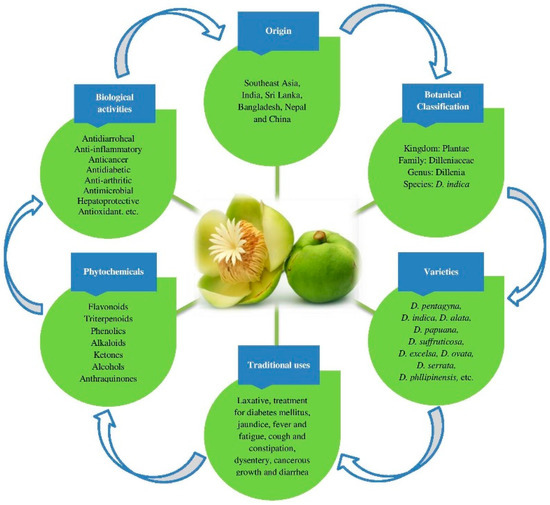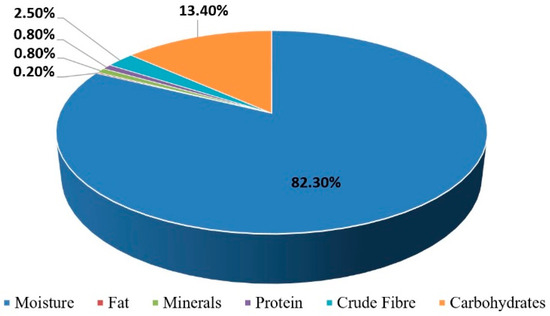You're using an outdated browser. Please upgrade to a modern browser for the best experience.
Please note this is a comparison between Version 1 by Deepanka Saikia and Version 2 by Camila Xu.
Elephant apple (Dillenia indica L.) grows wild in Southeast Asia’s forests, including in China, India, Nepal, Bangladesh, and Sri Lanka. Elephant apples are considered essential fruit crops because of their high nutritional value, which includes high levels of vitamin C, carbohydrates, fats, fibre, protein, minerals, and fatty acids. It is important to understand the nutritional value and health benefits of elephant apples in order to increase fruit intake in people’s daily diets.
- elephant apple
- bioactive compound
- herbal medicine
- phenolic compound
1. Introduction
India has over 45,000 different species of plants [1] and is among the 12 worldwide biodiversity centres [2]. Many plant species that are native to different forest areas of India are widely used by tribal and folk societies; however, the pharmacognostic and phytopharmacological importance of these plants is still unknown and remains inconclusive as they are seldom studied. Among these, there are a few plants of the Dilleniaceae family that have been reported to possess high therapeutic value, but there is still very little scientific understanding of Dilleniaceae cultivars. For instance, the genus Dillenia consists of 60 varieties, in which D. pentagyna, D. indica, D. alata, D. papuana, D. suffruticosa, D. excelsa, D. ovata, D. serrata, and D. phllipinensis, etc., are documented to have strong therapeutic values; two of these plants are only known to grow in India: D. pentagyna and D. indica [3]. Due to the presence of strong therapeutic abilities, plant parts such as fruits, leaves, and bark have received much attention as folk medicine. Moreover, many tribal and folk societies that are native to different areas prefer to ingest the raw fruits of D. indica and D. pentagyna [4][5][6][4,5,6].
Elephant apple (Dillenia indica L.) is a tree native to Southeast Asia, including India, China, Sri Lanka, Nepal, and Bangladesh (Figure 1). The elephant apple tree is a small- to medium-sized evergreen shrub that can grow up to 15 m tall. In particular, it grows extensively in the moist and evergreen forests of Northeastern India [7][8][9][7,8,9]. It grows in the sub-Himalayan region between Garhwal and Assam, Arunachal Pradesh, Tripura, Manipur, West Bengal, Bihar, and Orissa along with Central and Southern India, and in forests at low and medium altitudes in Nepal, Bangladesh, and Sri Lanka [10][11][12][10,11,12]. It was introduced in 1908 in the Philippines and has now spread across the whole continent [13].

Figure 1.
Production of elephant apple.
Elephant apple’s leaves, bark, and fruits contain a large number of flavonoids and triterpenoids (lupene-type), along with phenolics, ketones, phytosteroids, alcohols, and anthraquinones. Diverse forms of active substances, such as betulin, myricetin, dillenetin, betulinic acid, β-sitosterol, kaempferol, stigmasterol, quercetin, and rhamnetin, contribute to the range of phytochemicals of therapeutic importance in elephant apple. The key chemical constituents are betulin and betulinic acid (lupene-type triterpenoids), which have a wide range of therapeutic properties [12][14][12,14]. The general aspects and characteristics of elephant apple that are exploited for common and traditional uses are shown in Figure 2.

Figure 2.
Principal generalities of elephant apple fruit.
Several scientific and clinical investigations have been conducted over the years to determine the beneficial effects of the consumption of elephant apple. Several studies have reported the functional activity of elephant apple, including free radical scavenging, haematoprotective, antidiabetic, anti-inflammatory, and antimicrobial properties [14][15][16][17][18][19][14,15,16,17,18,19].
2. Classification and Chemistry
Elephant apple (Dillenia indica) belongs to the family Dilleniaceae. Previous studies have highlighted the presence of primary and secondary metabolites in elephant apple. The primary metabolites, like proteins, minerals, fats, crude fibre, and carbohydrates, that are present in elephant apples are shown in Figure 3 [20]; they are mainly responsible for cell maintenance. Compared to primary metabolites, the chemical structure and properties of secondary metabolites are complex and responsible for plant protection [21]. Using different solvents, the fruits were found to contain flavonoids, phytochemicals, steroids, triterpenoids, and alkaloids, along with tannins [22].

Figure 3.
Approximate composition of edible portion of elephant apple.
The bark of elephant apple is found to contain 10% tannin, triterpenoids, like betunaldehyde, lupeol, and betulinic acid, as well as flavonoids such as rhamnetin, dillenetin, dihydro-isorhamnetin, myricetin, quercetin derivatives, naringenin, and kaempferol glucoside [23][24][23,24]. The presence of betulin, betulinic acid, lupeol, betulinaldehyde, sitosterol, and flavonol myricetin in elephant apple bark has also been successfully identified [25].
Elephant apple is a good source of ash, acid-insoluble ash, and water-soluble ash. A study that focused on phytochemicals indicated that the plant contains terpenoids, tannins, glycosides, alkaloids, etc. [26]. Moreover, elephant apple seeds also contain fixed oils, sterols, colours, saponins, glycosides, proteins, sugars, free amino acids, tannins, and free acids [27].
Secondary metabolites are natural products that provide bioactive compounds to the plant. Flavonoids, terpenoids, and alkaloids are essential secondary metabolites that function as free radical scavengers, insect pollinators, and phytoalexins. Others may be active in antimicrobial action or cellular signalling. Flavonoids, terpenoids, alkaloids, and other secondary metabolites are reported to be found in elephant apple and are classified according to their chemical structure, as shown in tables below. Flavonoids and triterpenoids (lupine-type) are the essential chemical compounds isolated from elephant apple. The richness of phytochemistry in elephant apple is also enhanced by several other secondary metabolites, including phytosteroids, ionone, anthraquinone, diterpene, phenolics, ketones, and alcohols.
2.1. Phenolic Compounds
Phenolic compounds, such as flavonoids, allied phenolic, and polyphenolic compounds, are among the most common secondary metabolites found in plants. Flavonoids are polyphenolic compounds that consist of a wide group of plant secondary metabolites [28]. These are classified into flavonols, flavanones, flavones, isoflavone, anthocyanin, catechin, and chalcones according to their molecular structures. The reported health-promoting benefits of such natural products as antioxidants are very significant [22][29][30][22,29,30]. So far, there have been over 9000 recorded flavonoids [31]. Elephant apple is found to contain different classes of flavonoids and phenolic compounds according to their chemical structure.
Phenolic compounds are natural derivatives that develop biogenetically from the shikimate/phenylpropanoid process, which produces phenylpropanoids directly. It has one or more hydroxyl substituents on its aromatic ring [32][33][32,33]. These compounds may play a significant role in plant growth and reproduction, defending against pests and pathogens [30]. In addition, these compounds further contribute to fruit colour and sensory attributes [21]. Methanol extract obtained from the fruit of elephant apple is reported to contain 34% of the total phenolics and polysaccharides, such as arabinogalactans [34].
The ethyl acetate fraction of elephant apple bark was analysed using paper spray ionisation mass spectroscopy [35]. It reported the presence of three phenolic acids, namely 2-O-caffeoylhydroxycitric acid, 3,5-dihydroxy-4-methoxybenzoic acid, and 2-caffeoylisocitric acid, along with five flavonoids: 6,7,3′-trihydroxy-2′,4′-dimethoxyisoflavan (bryaflavan), amoradinin, 5,7-dimethoxyapigenin, formononetin 7-glucoronide, and mallotus B (isoallorottlerin). Moreover, an ethanolic extract of elephant apple bark, wood, and pericarp was found to contain flavonoids such as quercetin, isorhamnetin, dillenetin, naringenin, sitosterol, kaempferol, dihydrokaempferol, and gallic acid [36]. In addition, the ethanolic extract of the bark of elephant apple was identified to contain two flavonoids, kaempferol glucoside and quercetin derivatives, alongside triterpenoids [37]. The fruit of elephant apple was also found to contain cycloartenone and n-hentriacontanol. Fleshy sepals of the fruit were rich in glucose, malic acid, and arabinogalactans. The bark and wood of elephant apple contained myricetin, dihydroisorhamnetin, hydroxylactone, and glucosides [38].
Furthermore, fresh elephant apple leaves were analysed through phytochemical experiments using acid-hydrolysis, which resulted in the identification of dihydrokaempferide and naringenin 7-glucosides, as well as the formation of 10 flavonols [39]. The methanolic extract of elephant apple leaves revealed a wide range of bioactive phytochemicals, indicating its potential as a source of therapeutically effective compounds [40]. Flavonoids; including quercetin and kaemferol; amino acids, like glutamic acid; and sterols, such as cholesterol, were found in elephant apple leaves. Additionally, unidentified compounds were observed during TLC chromatography. The involvement of flavonoids in various biological activities, including antibacterial, anti-inflammatory, anti-allergic, antiviral, anti-tumour, and neurodegenerative disease treatments, has been well documented. They also exhibit cytotoxic effects and play roles in preventing lipid peroxidation, capillary permeability, and platelet aggregation. Furthermore, flavonoids act as potent antioxidants, free radical scavengers, and divalent cation chelators due to their strong hydrogen-donating ability [41].
2.2. Terpenoids
Triterpenoids (and steroids) are among the largest higher terpenoid families, containing over 1500 compounds and about 40 skeletal forms. Because of the links between cholesterol and steroids and heart disease and human physiology, sterols (generally from C27 to C30) are treated differently in medicine than terpenes. However, sterols, which are not triterpenes, may be considered a subset of 30-carbon higher terpenoids [42][46]. Phytosterols, such as stigmasterol, campesterol, and sitosterol, are a large class of organic compounds, known as sterols or steroidal alcohols, found in plants. In addition, phytosterols have been shown in clinical trials to block cholesterol absorption sites in the human intestine, lowering cholesterol levels [43][47]. Elephant apple leaves are found to contain flavonoids, tannins, triterpenoids, and steroids; petroleum extract of elephant apple leaves is found to contain sitosterol, cycloartenone, betulin, and n-hentriacontanol, while chloroform extract is found to contain betulinic acid [44][48]. After fractionation with n-hexane and chloroform, methanolic extracts of the leaves form compounds like β-sitosterol, betulinic acid, dillenetin, and stigmasterol [45][43].
Betulinic acid was isolated and quantified from various fractions (n-butanol, ethyl acetate, methanol, and water) using validated HPLC. The ethyl acetate fraction showed the highest level (97.99 ± 7.61 mg/g fraction) [46][49]. Betulinic acid was found in significant amounts in the pericarp, bark, timber [36], and fruit [46][49] of elephant apple. The methanolic extract of elephant apple contains lupeol, betulin, and β-sitosterol [47][50]. Upon partitioning with n-hexane, chromatographic column isolation of the methanolic extracts from elephant apple stems yielded four compounds: stigmasterol, betulinic acid, betunaldehyde, and lupeol [15]. Betulin, β-sitosterol, and betulinic acid were identified in all parts of elephant apple in the analysis above. Additionally, a new hydroxylactone, classified as 3β-hydroxylupane-13β-28-lactone, was extracted and characterised based on spectroscopy findings and positive Liebermann–Burchard and Zimmerman tests [25]. Furthermore, the ethyl acetate fraction of elephant apple bark reported the discovery of a new triterpenoid, nutriacholic acid, using paper spray ionisation mass spectroscopy [35].
Terpenoids, including triterpenoids and steroids, are associated with various biological behaviours. Functionally, they play a significant role in cell physiology, and modern omics approaches are being used to isolate and identify novel terpenoid compounds for potential industrial applications. Elephant apple, a plant from the Dilleniaceae family, contains different classes of terpenoids (triterpenoids and steroids).
2.3. Alkaloids
The presence of a nitrogen atom in a heterocyclic ring unites alkaloids, a complex group of low-molecular-weight compounds. They are classified based on the composition of their carbon skeletons. Alkaloids are mainly derived from amino acids and are present in around 20% of plant species [48][53].
The ethyl acetate fraction of elephant apple bark using paper spray ionisation mass spectroscopy reported twelve alkaloids, such as hydroxymethylserine, 5-acetyl-2,4-dimethylthiazole, γ-Aminobutyric acid (GABA), 4-methylthiazole-5-propionic acid, N-isopropylhydrazinecarboxamide, dialanine, triethanolamine, 1,3-bis(carbamoylcarbamoyl)urea (Carbonyldibiuret), 2-(glucosyloxy) isobutyraldoxime, L-α-Aminosuberic acid, linamarin, and N-acetyl-3,5,11,18-tetrahydroxyoctadecyl-2-amine [35].
Alkaloids are secondary metabolites with several therapeutic and pharmacological impacts. Because of their plausible bioactivity, around 20,000 alkaloids have been used as pharmaceuticals, stimulants, narcotics, and poisons. Certain alkaloids have been confirmed to be potentially toxic when consumed in large quantities. Many experiments have recently been carried out to classify alkaloids in underutilised fruits and vegetables. Furthermore, alkaloid-containing compound biosynthesis, aggregation, genomics, and metabolomics have also all been extensively studied [49][54].
2.4. Miscellaneous Compounds
Elephant apple contains many other compounds besides flavonoids, triterpenoids, and alkaloids, including chromane, dicarboxylic acid, fatty acid, anthraquinone, ketones, alcohols, and ethyl maltol, as well as Na and K adducts of glucose. These compounds were collected from the plants’ twigs, fruits, bark, and leaves.
